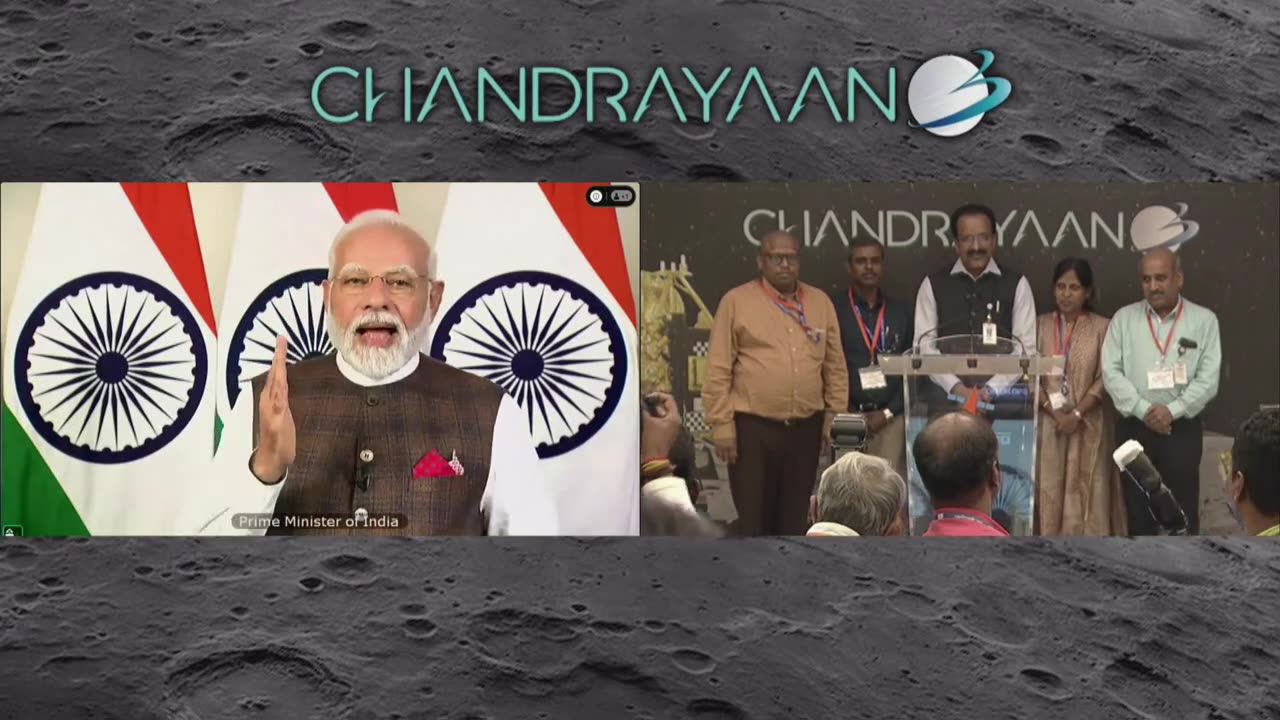Premium Only Content

Chandrayaan-3 Mission Soft-landing LIVE Telecast
Chandrayaan-3 is a follow-on mission to Chandrayaan-2 to demonstrate end-to-end capability in safe landing and roving on the lunar surface. It consists of Lander and Rover configuration. It will be launched by LVM3 from SDSC SHAR, Sriharikota. The propulsion module will carry the lander and rover configuration till 100 km lunar orbit. The propulsion module has Spectro-polarimetry of Habitable Planet Earth (SHAPE) payload to study the spectral and Polari metric measurements of Earth from the lunar orbit.
Lander payloads: Chandra’s Surface Thermophysical Experiment (ChaSTE) to measure the thermal conductivity and temperature; Instrument for Lunar Seismic Activity (ILSA) for measuring the seismicity around the landing site; Langmuir Probe (LP) to estimate the plasma density and its variations. A passive Laser Retroreflector Array from NASA is accommodated for lunar laser ranging studies.
Rover payloads: Alpha Particle X-ray Spectrometer (APXS) and Laser Induced Breakdown Spectroscope (LIBS) for deriving the elemental composition in the vicinity of landing site.
More Details
Chandrayaan-3
Chandrayaan-3 Details
Launch Streaming
Brochure pdf icon PDF - 5.6 MB
Curtain Raiser Video
LVM3 M4 Onboard Video
Chandrayaan-3 Videos
Gallery
Appraisal
Press Release on Aug 05, 2023
Chandrayaan-3 consists of an indigenous Lander module (LM), Propulsion module (PM) and a Rover with an objective of developing and demonstrating new technologies required for Inter planetary missions. The Lander will have the capability to soft land at a specified lunar site and deploy the Rover which will carry out in-situ chemical analysis of the lunar surface during the course of its mobility. The Lander and the Rover have scientific payloads to carry out experiments on the lunar surface. The main function of PM is to carry the LM from launch vehicle injection till final lunar 100 km circular polar orbit and separate the LM from PM. Apart from this, the Propulsion Module also has one scientific payload as a value addition which will be operated post separation of Lander Module. The launcher identified for Chandrayaan-3 is LVM3 M4 which will place the integrated module in an Elliptic Parking Orbit (EPO) of size ~170 x 36500 km.
The mission objectives of Chandrayaan-3 are:
To demonstrate Safe and Soft Landing on Lunar Surface
To demonstrate Rover roving on the moon and
To conduct in-situ scientific experiments.
To achieve the mission objectives, several advanced technologies are present in Lander such as,
Altimeters: Laser & RF based Altimeters
Velocimeters: Laser Doppler Velocimeter & Lander Horizontal Velocity Camera
Inertial Measurement: Laser Gyro based Inertial referencing and Accelerometer package
Propulsion System: 800N Throttleable Liquid Engines, 58N attitude thrusters & Throttleable Engine Control Electronics
Navigation, Guidance & Control (NGC): Powered Descent Trajectory design and associate software elements
Hazard Detection and Avoidance: Lander Hazard Detection & Avoidance Camera and Processing Algorithm
Landing Leg Mechanism.
To demonstrate the above said advanced technologies in earth condition, several Lander special tests have been planned and carried out successfully viz.
Integrated Cold Test - For the demonstration of Integrated Sensors & Navigation performance test using helicopter as test platform
Integrated Hot test – For the demonstration of closed loop performance test with sensors, actuators and NGC using Tower crane as test platform
Lander Leg mechanism performance test on a lunar simulant test bed simulating different touch down conditions.
#Chandrayaan3 #ISRO #LunarExploration #MoonMission #SpaceResearch #IndianSpaceAgency #SpaceExploration #LunarSurface #ScientificExperiments #MoonData #SpaceTechnology #india #indian #indianarmy #indiaspacemission #indiaspacetechnology #indiaspace
-
 57:38
57:38
The Tom Renz Show
5 hours agoMerry Christmas - The Tom Renz Show Christmas
60.4K14 -
 2:59:10
2:59:10
Wendy Bell Radio
16 hours agoThe Bridge Too Far
145K289 -
 1:03:45
1:03:45
Donald Trump Jr.
1 day agoHappy Festivus: Airing Our Grievances and Stopping The Swamp w/Sean Davis | TRIGGERED Ep.201
410K535 -
 1:30:30
1:30:30
Game On!
19 hours ago $7.59 earnedTop 5 things you need to know for Sports Christmas!
63.9K5 -
 1:58:10
1:58:10
Robert Gouveia
1 day agoMatt Gaetz REJECTS Report, Sues Committee; Luigi Fan Club Arrives; Biden Commutes; Festivus Waste
288K229 -
 1:31:40
1:31:40
Adam Does Movies
1 day ago $15.83 earnedThe Best & Worst Christmas Movies! - LIVE!
112K8 -
 58:10
58:10
Kimberly Guilfoyle
1 day agoAmerica is Back & The Future is Bright: A Year in Review | Ep. 183
200K81 -
 3:03:27
3:03:27
vivafrei
1 day agoEp. 242: Barnes is BACK AGAIN! Trump, Fani, J6, RFK, Chip Roy, USS Liberty AND MORE! Viva & Barnes
273K263 -
 2:05:48
2:05:48
2 MIKES LIVE
12 hours agoTHE MIKE SCHWARTZ SHOW with DR. MICHAEL J SCHWARTZ 12-24-2024
43.1K5 -
 1:14:17
1:14:17
MTNTOUGH Fitness Lab
1 day agoNavy SEAL Dom Raso: The Cold, Hard Truth About Modern Brotherhood | MTNPOD #96
32.6K4